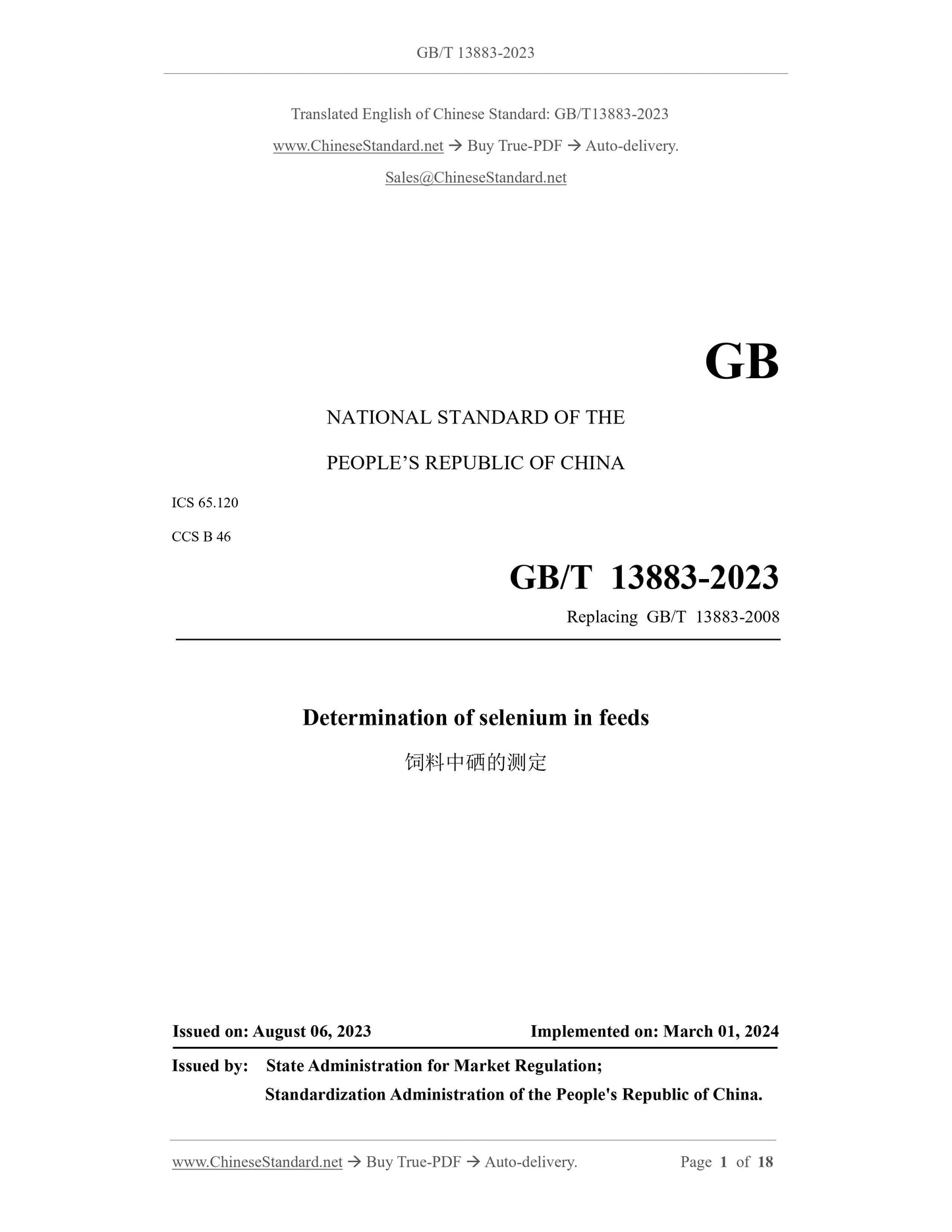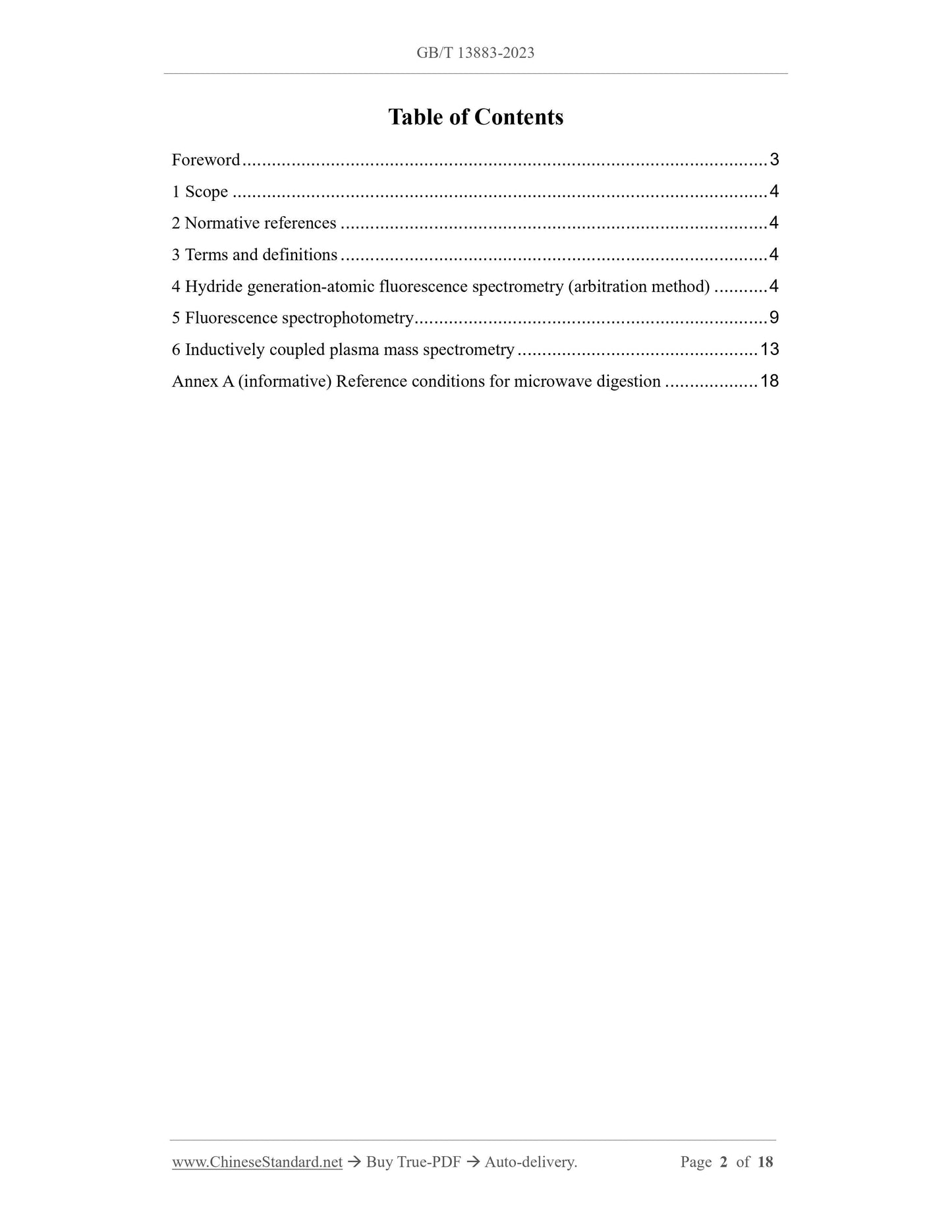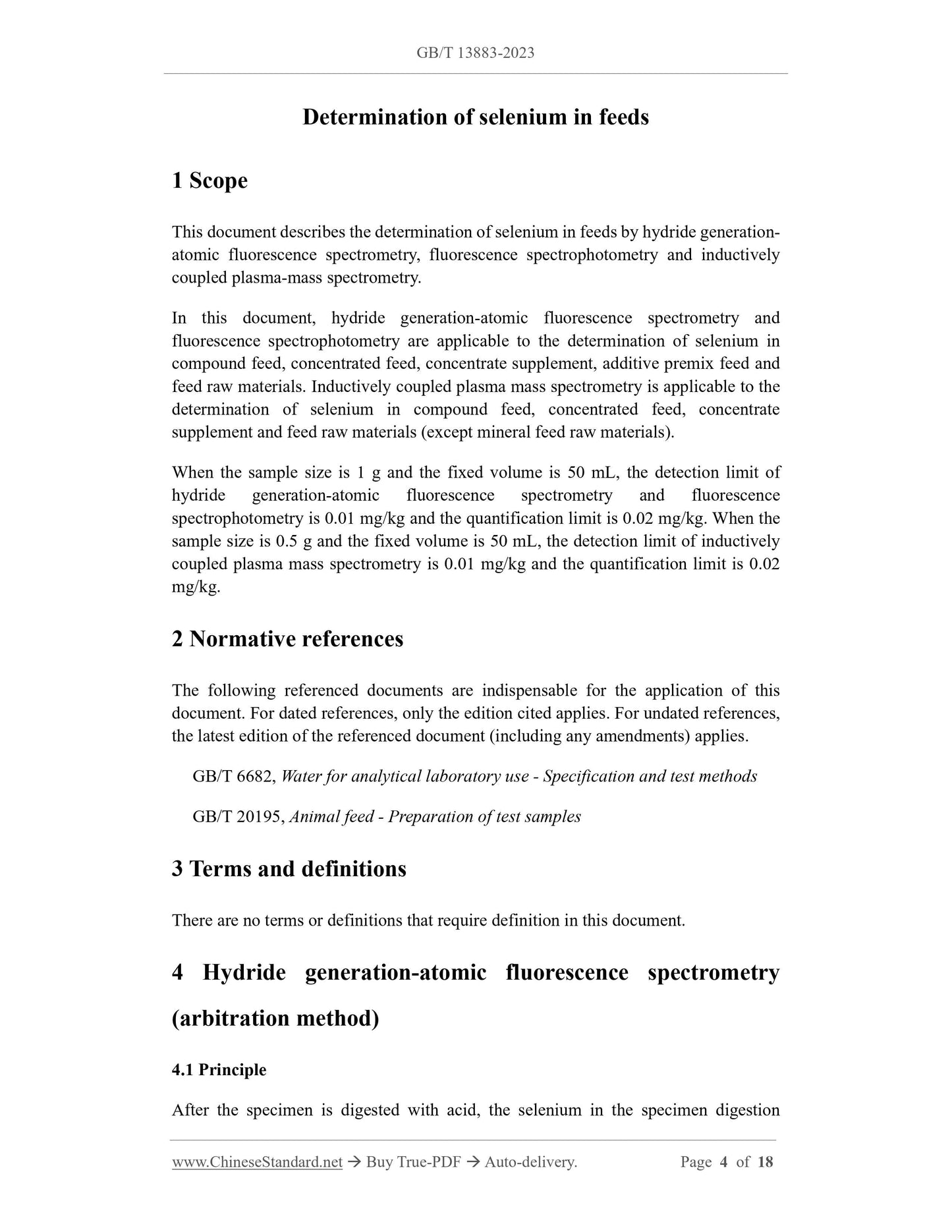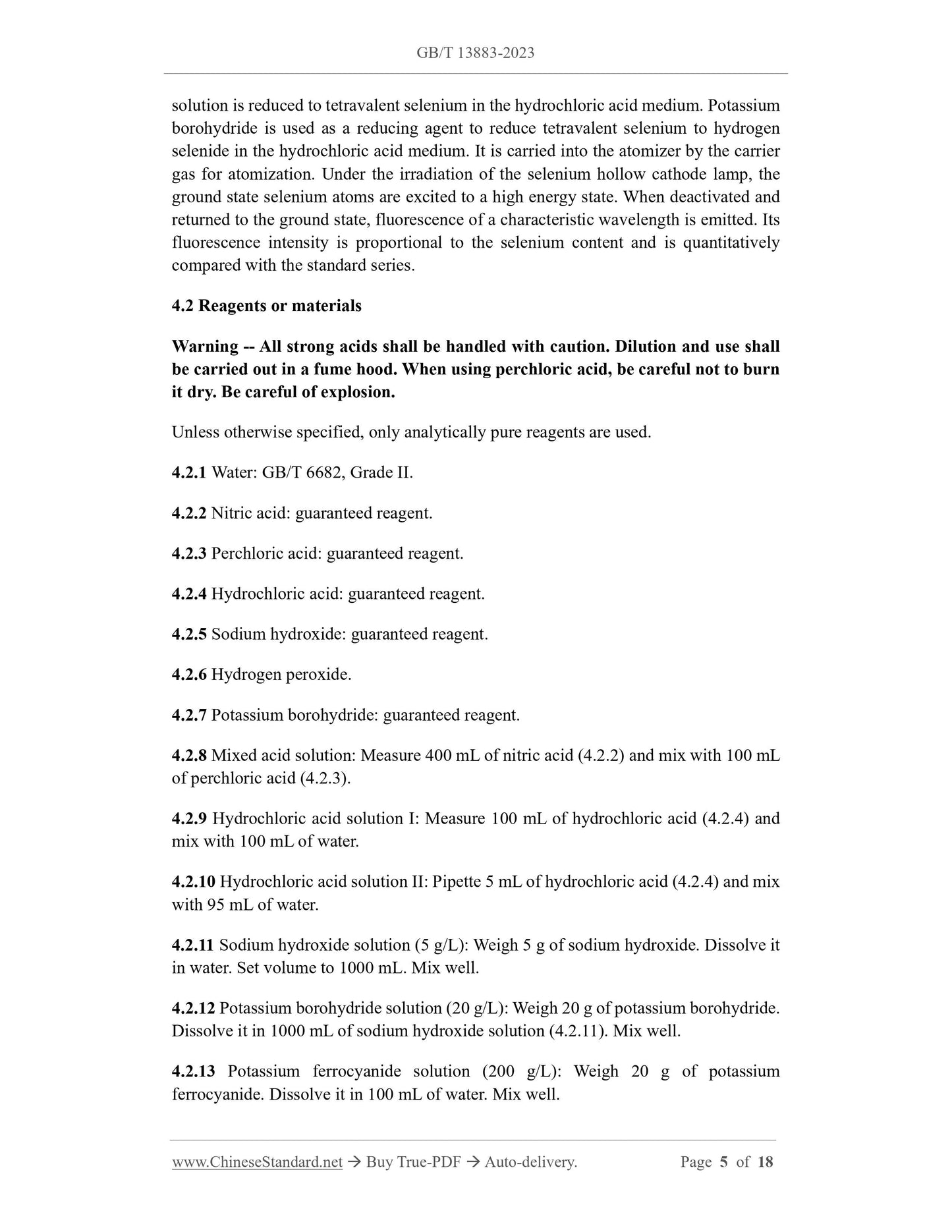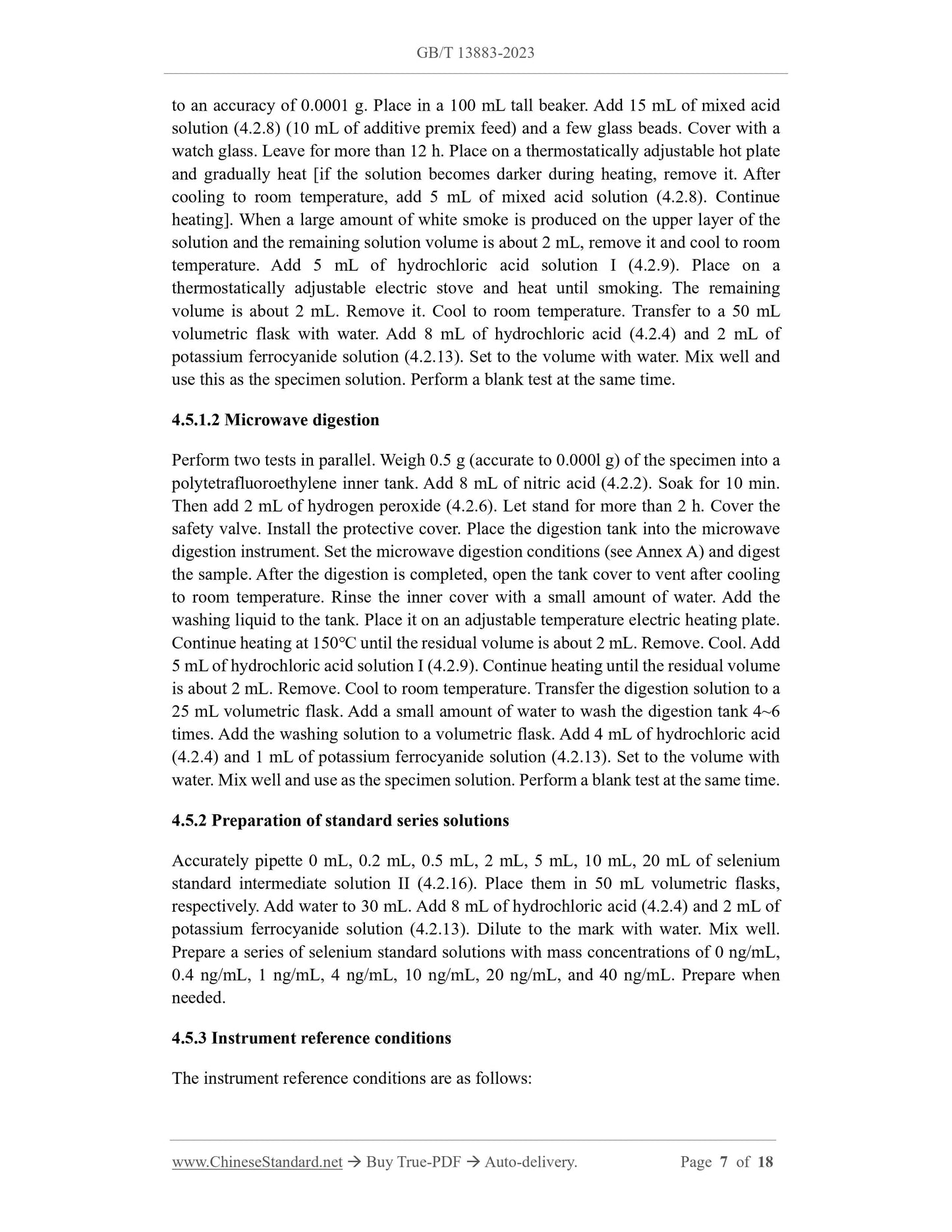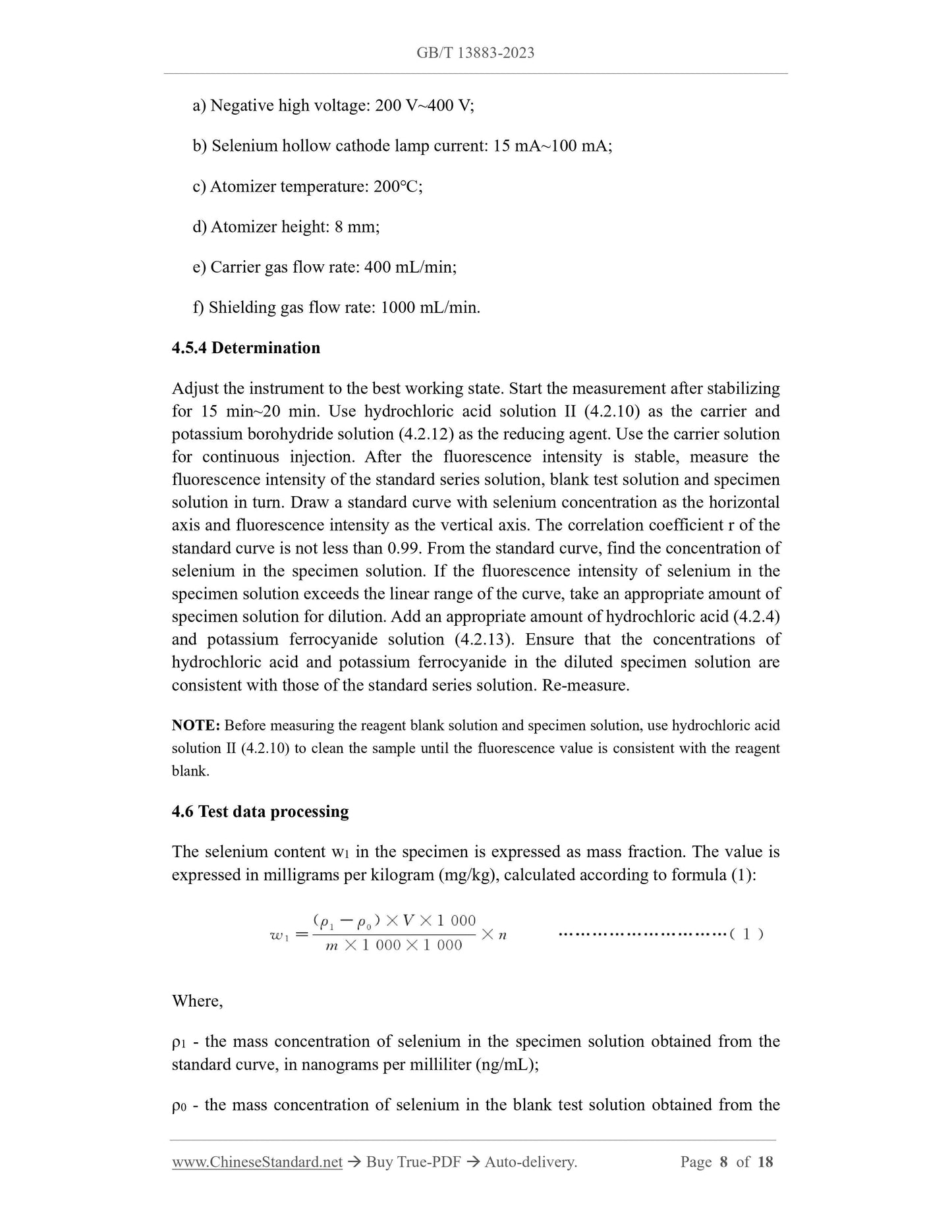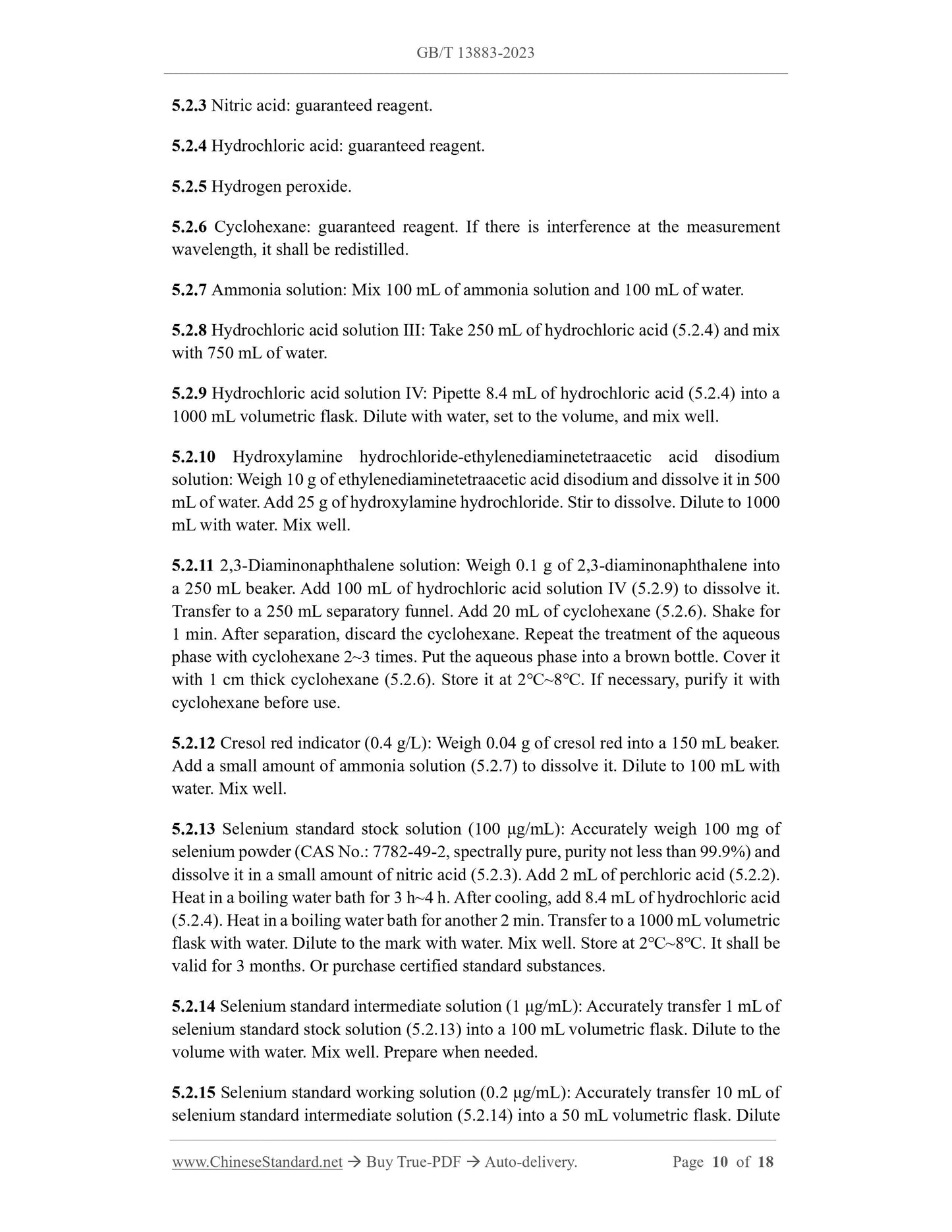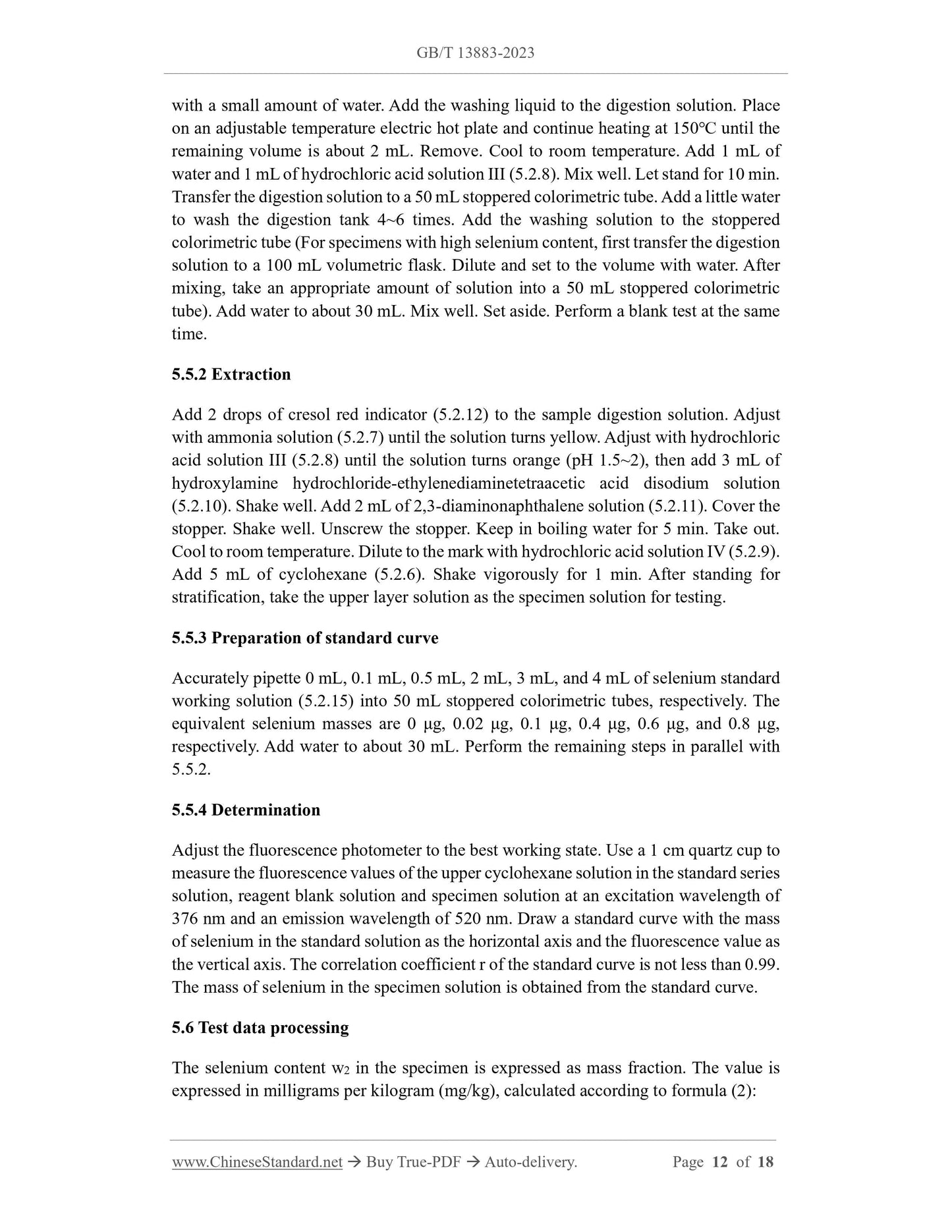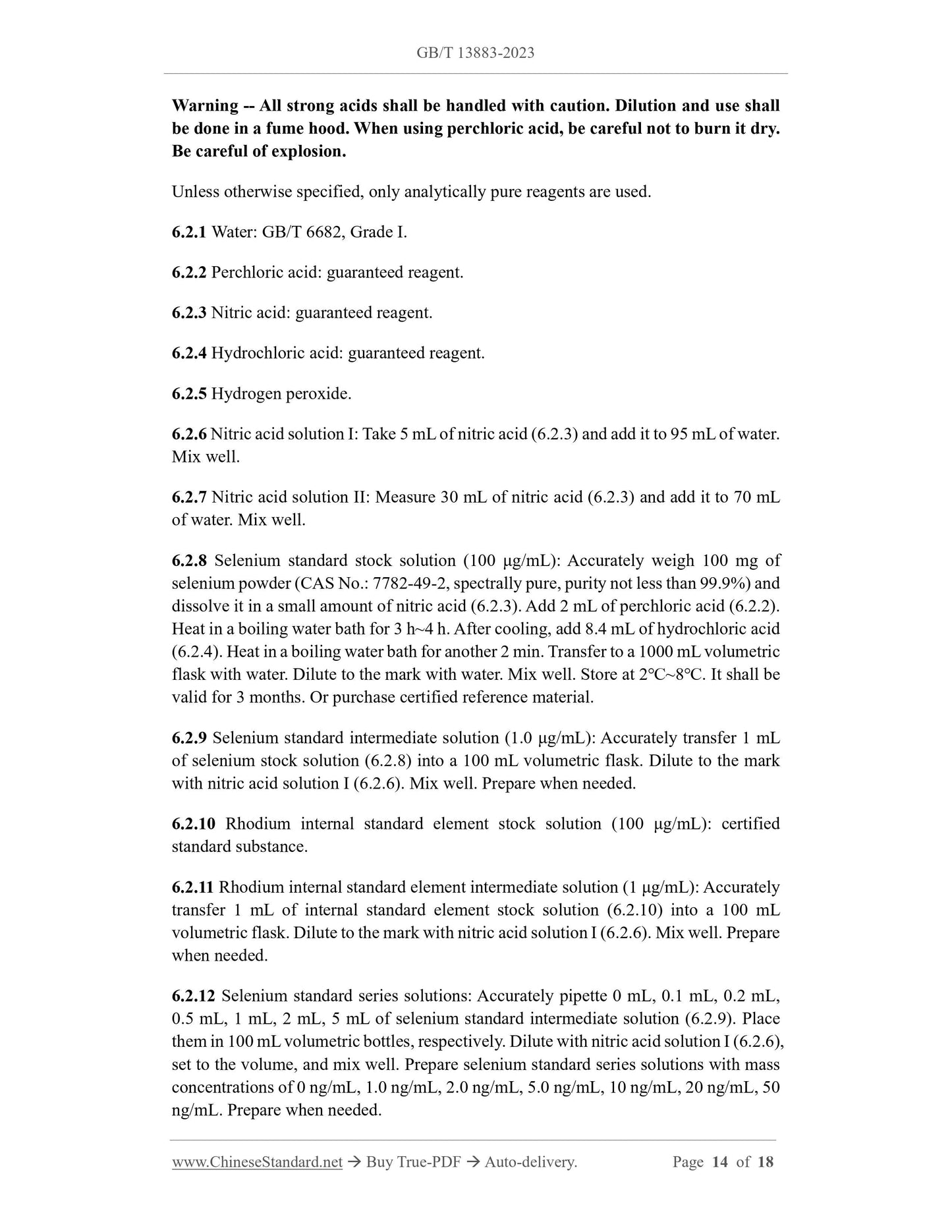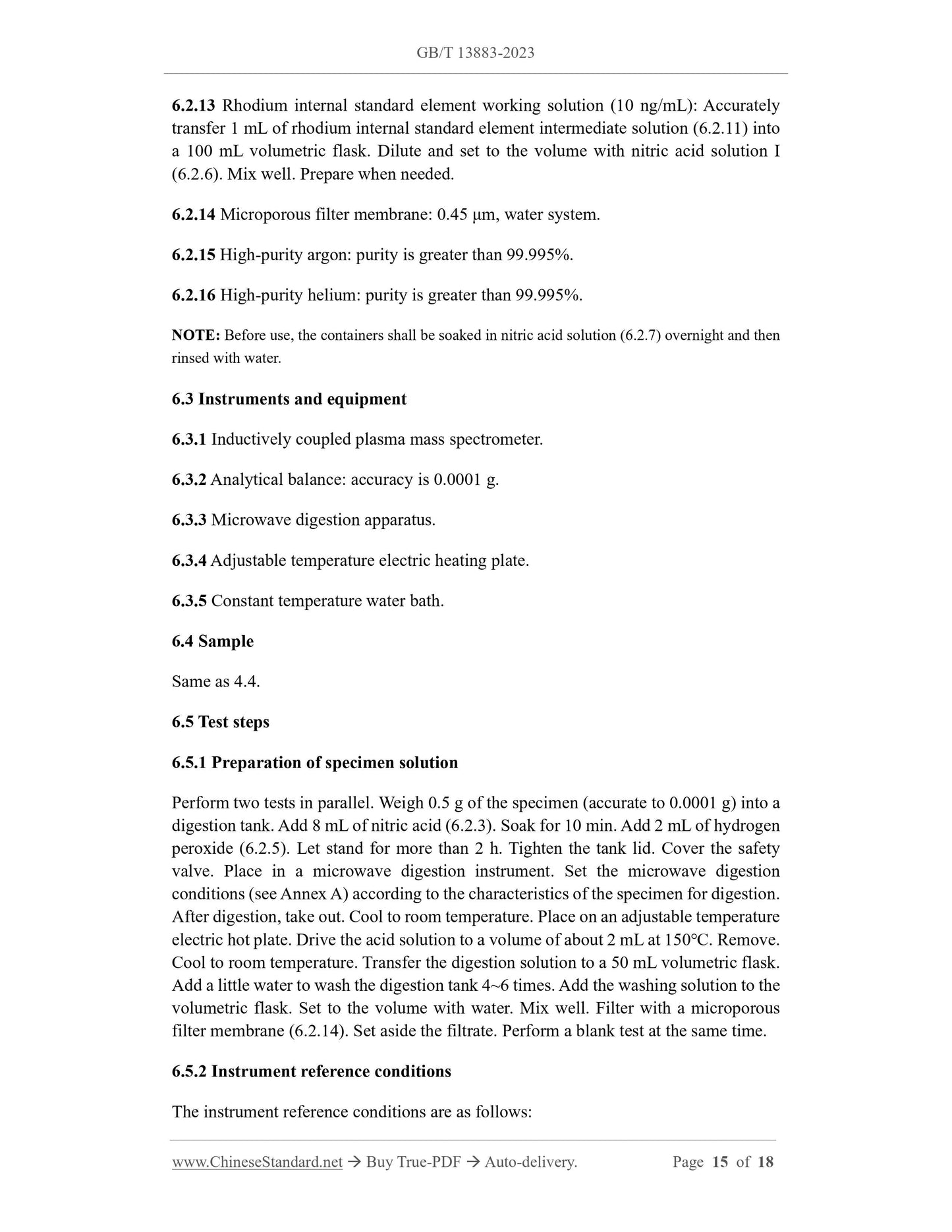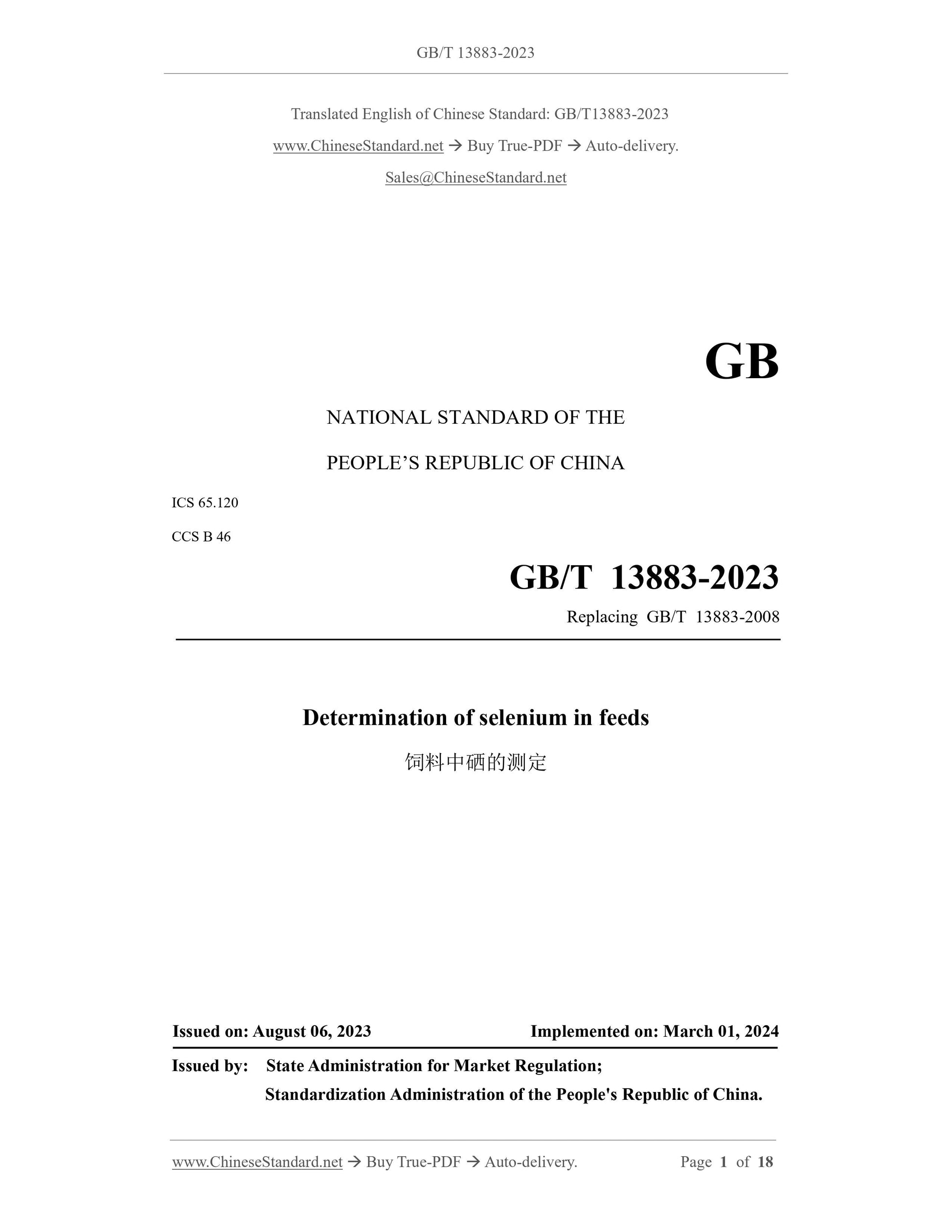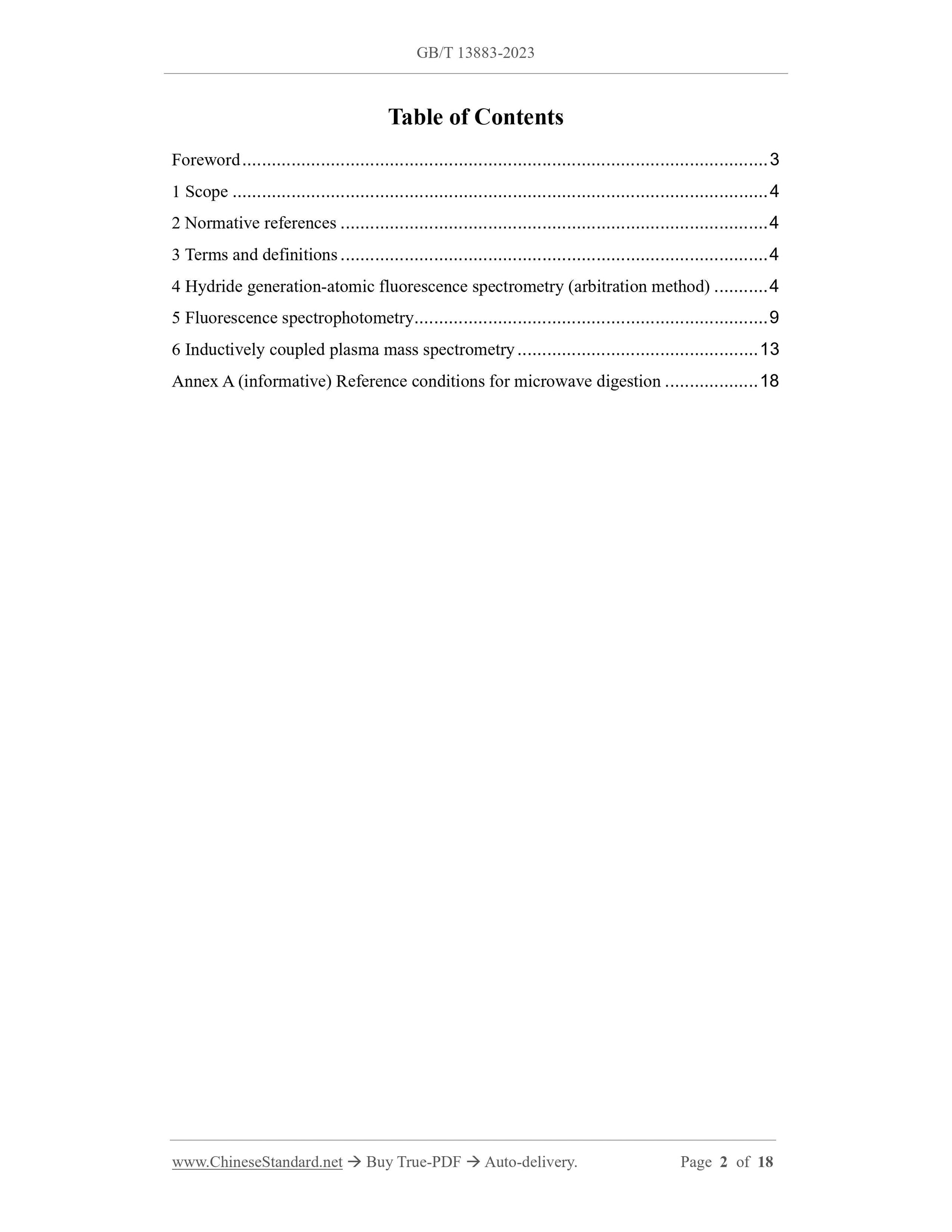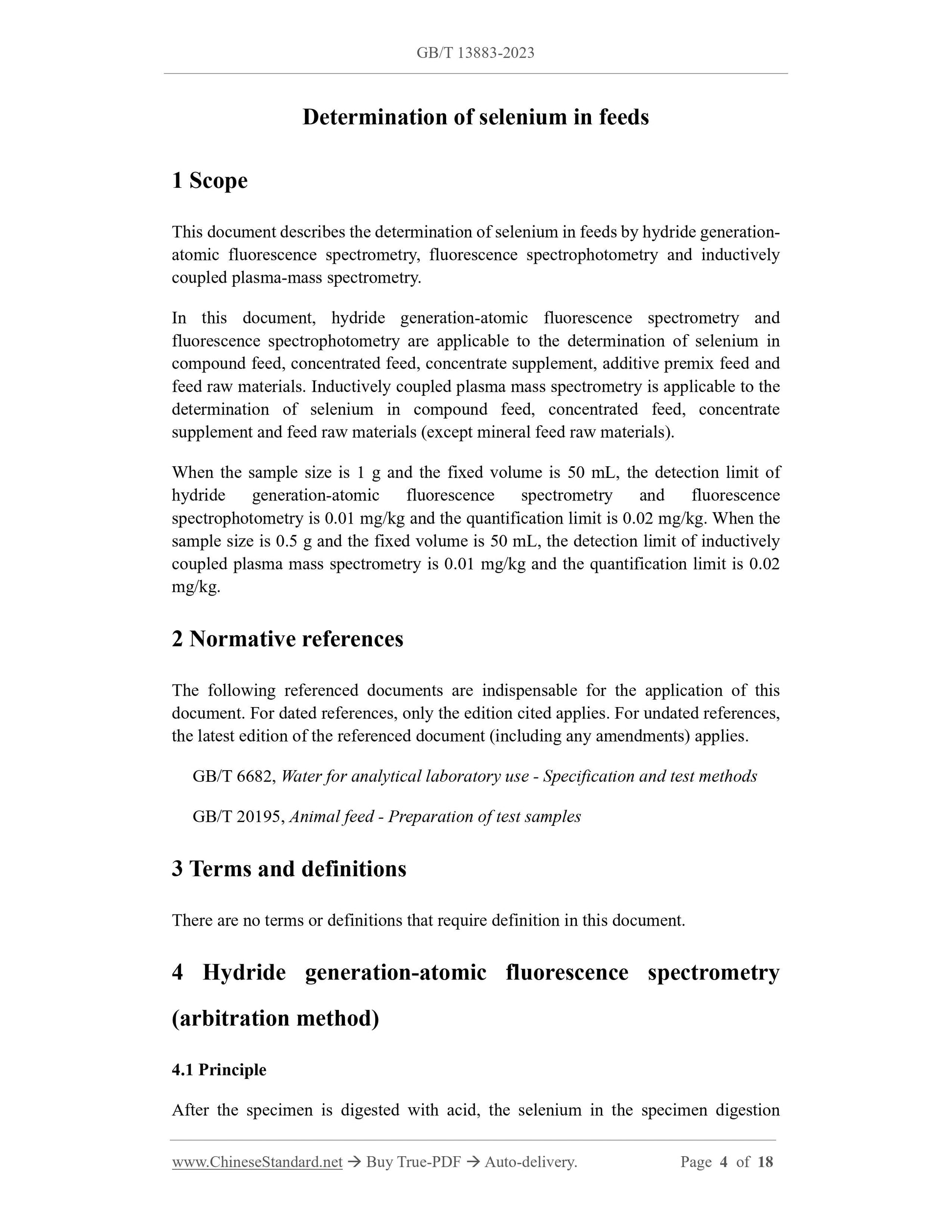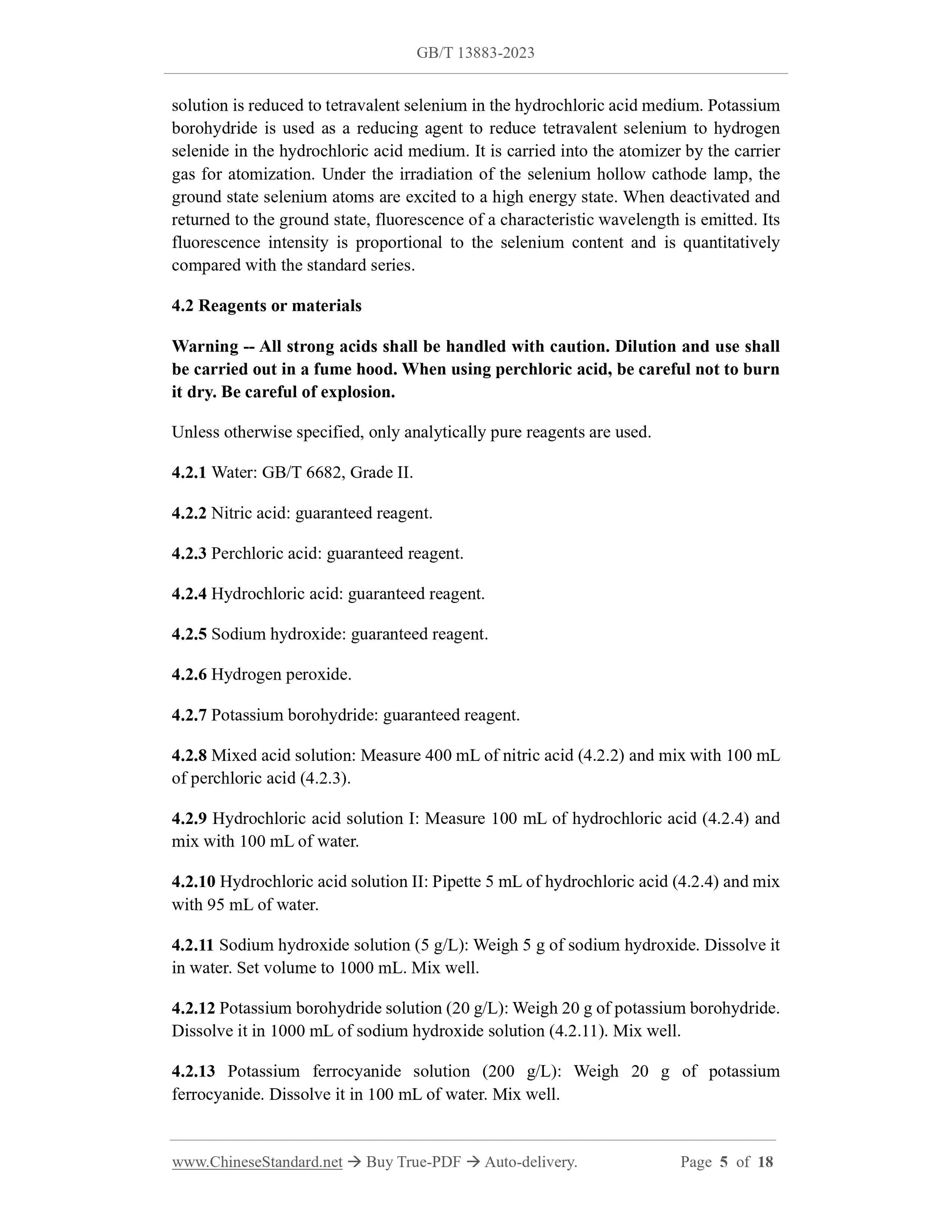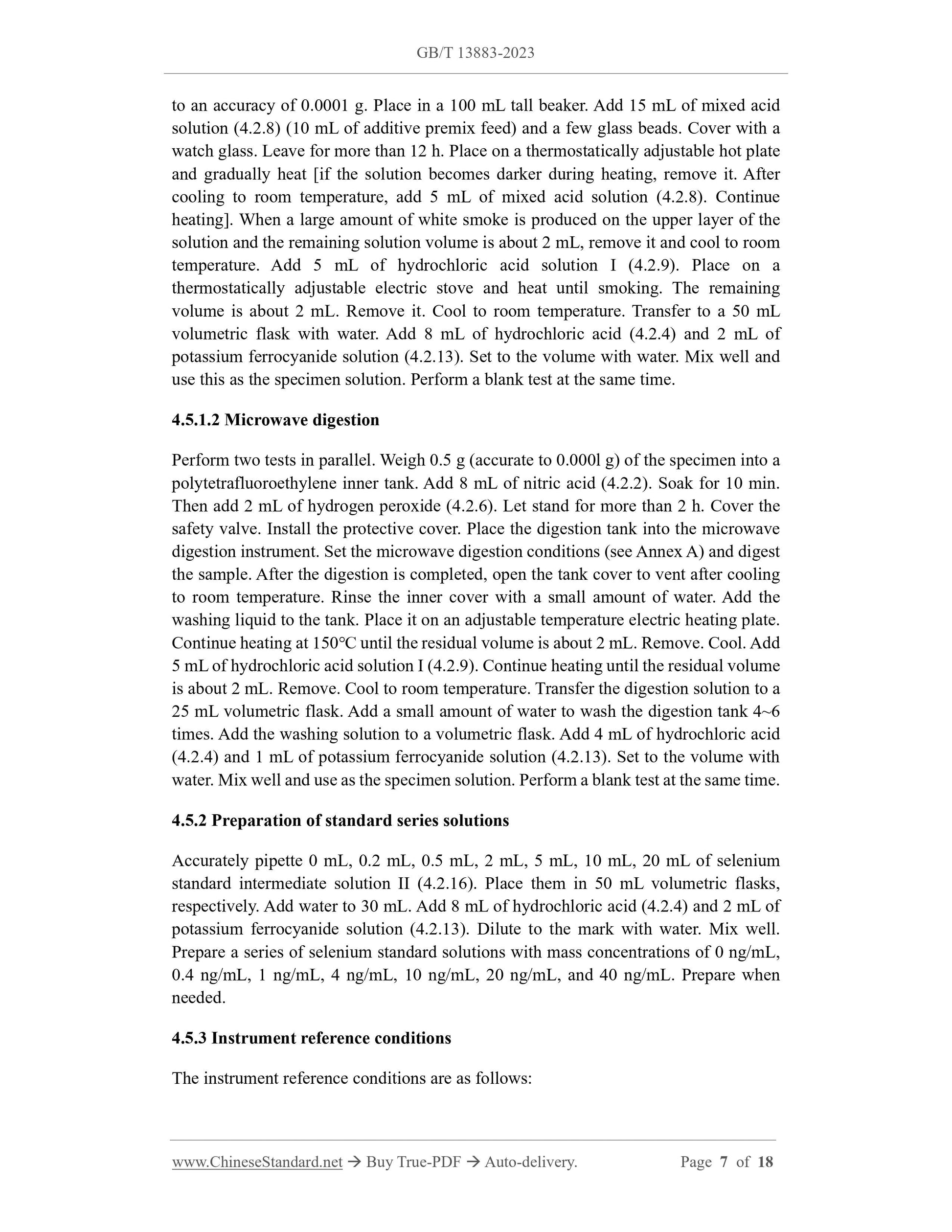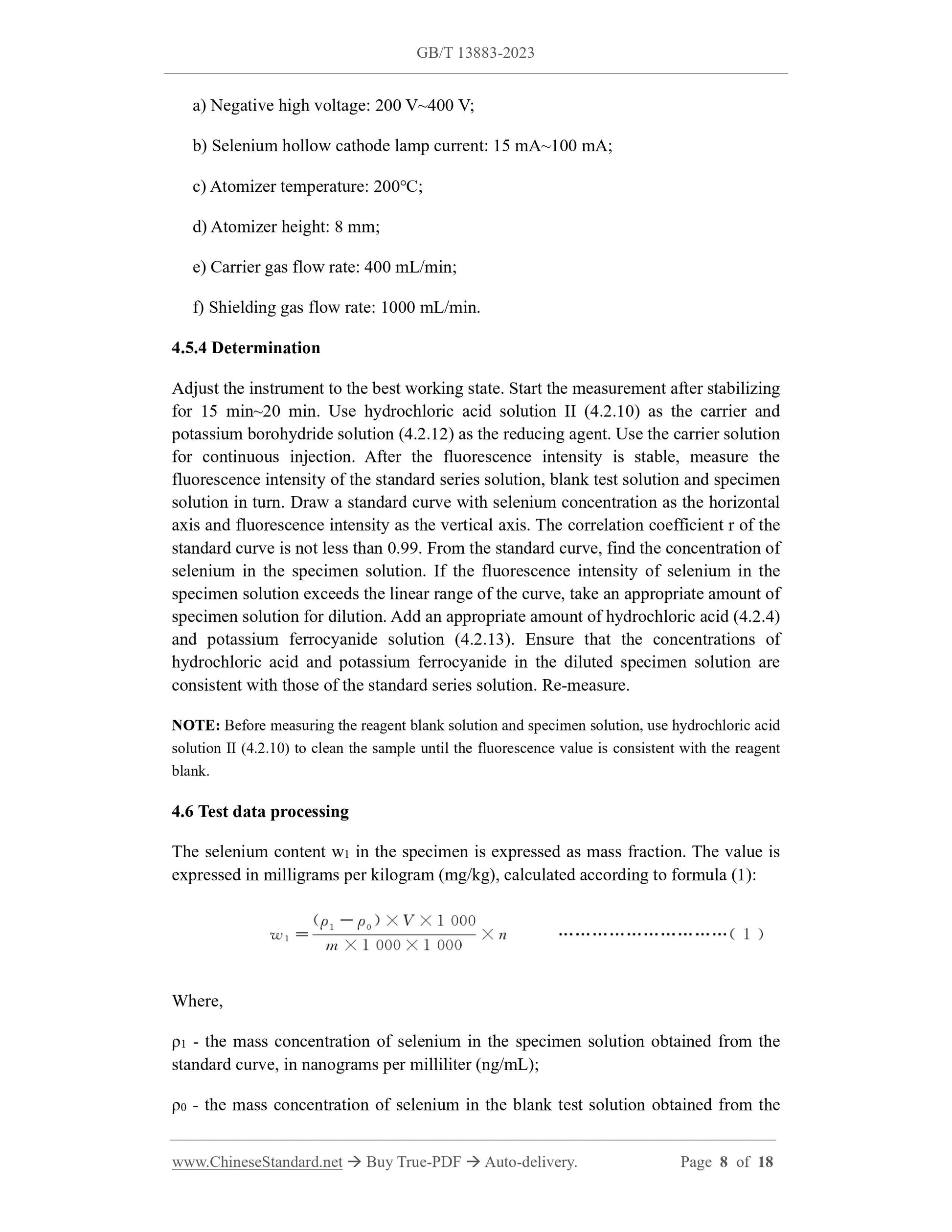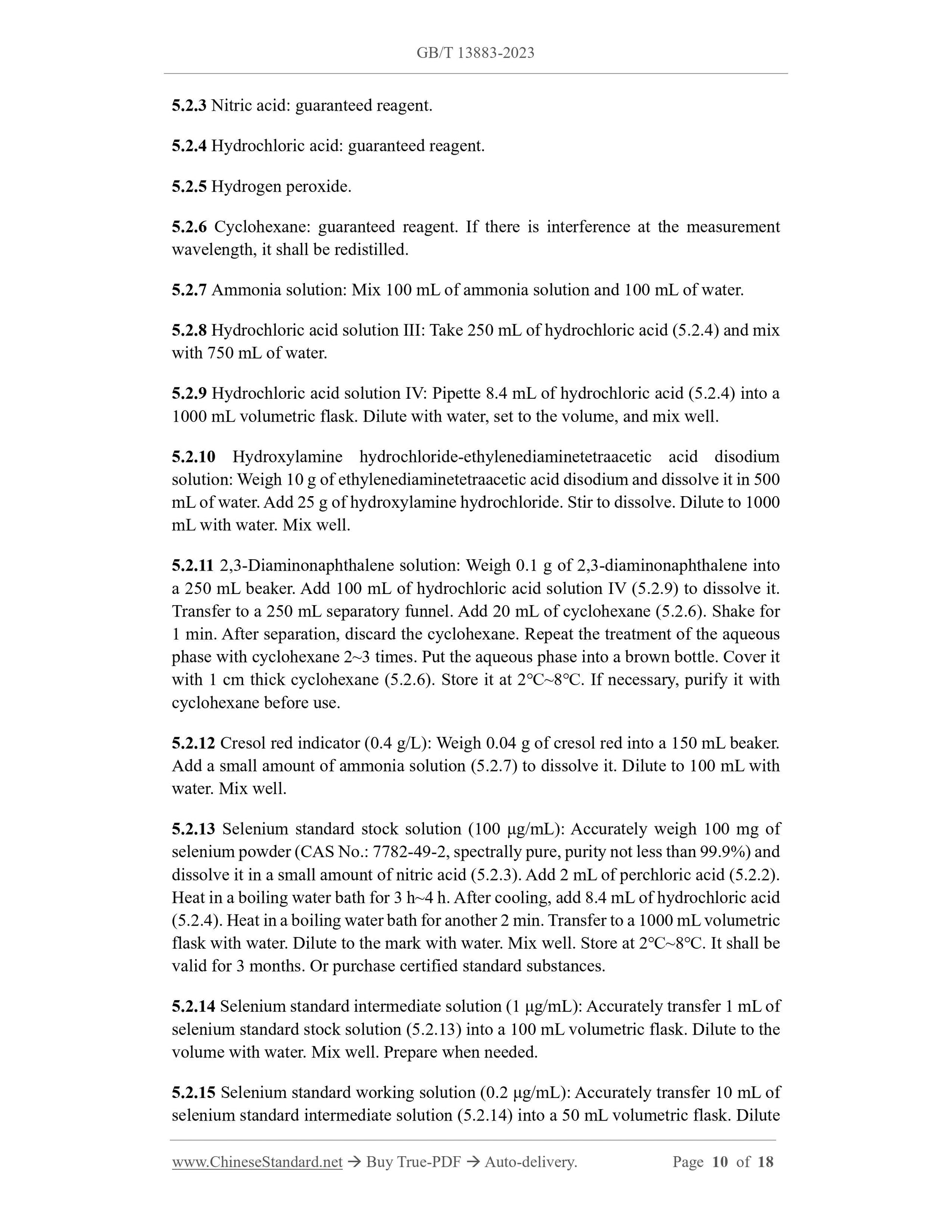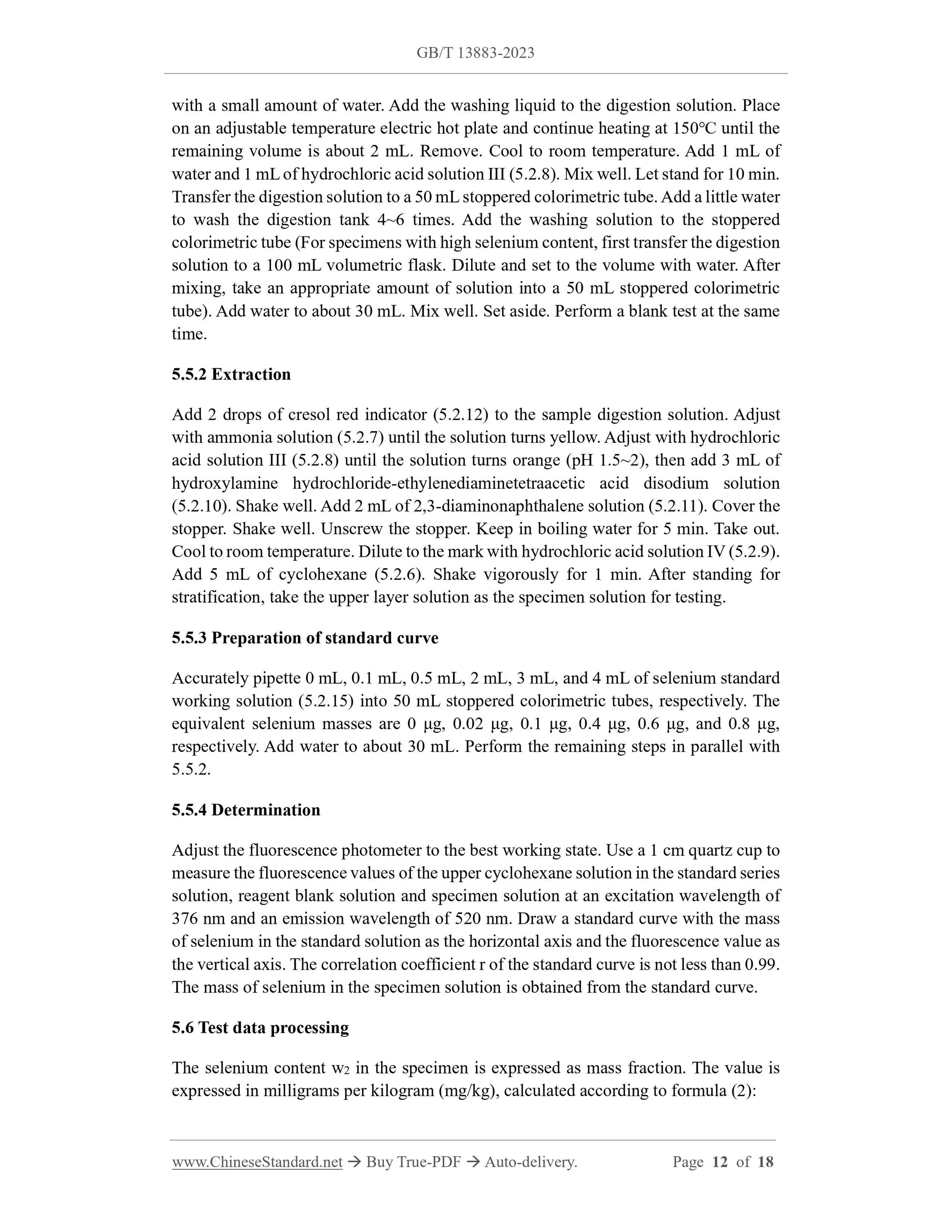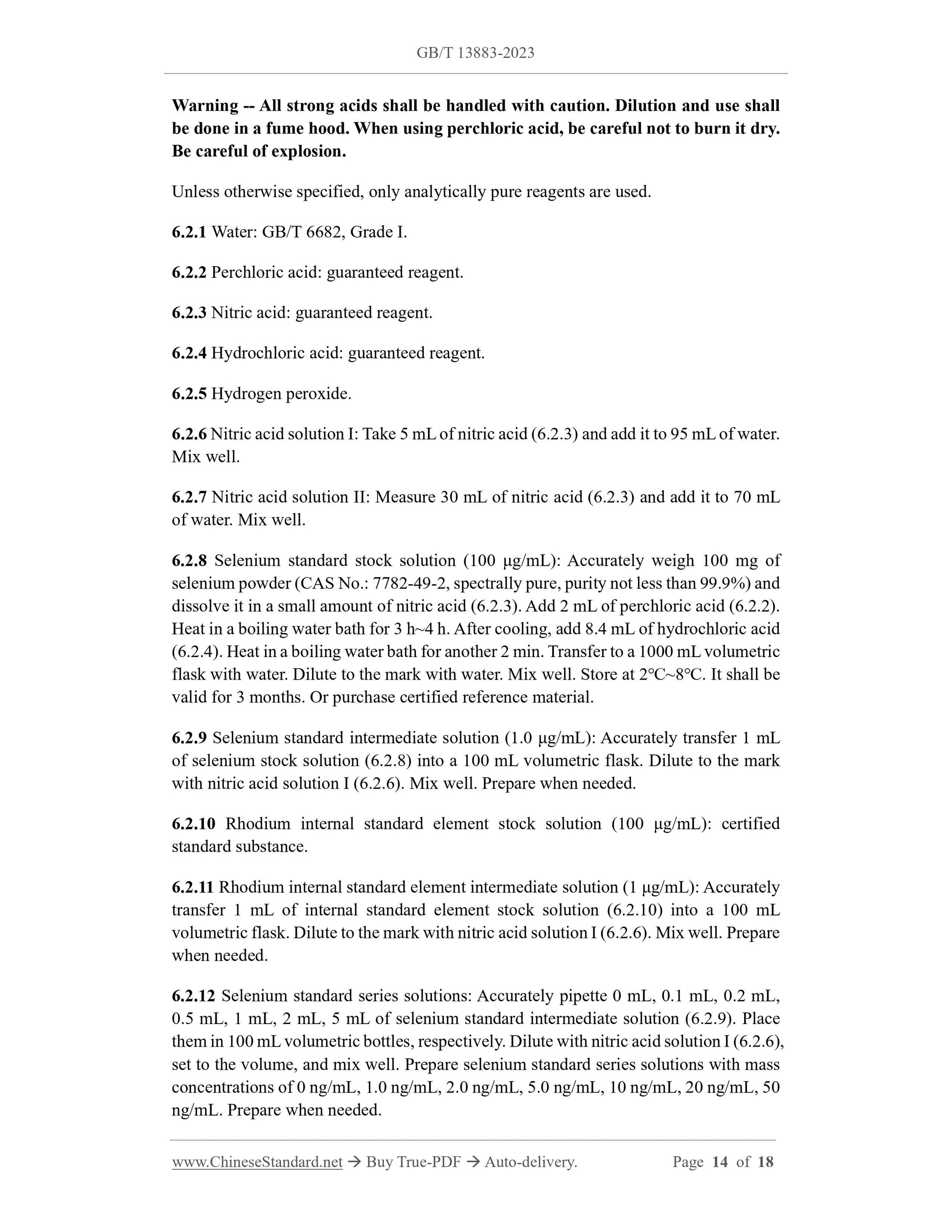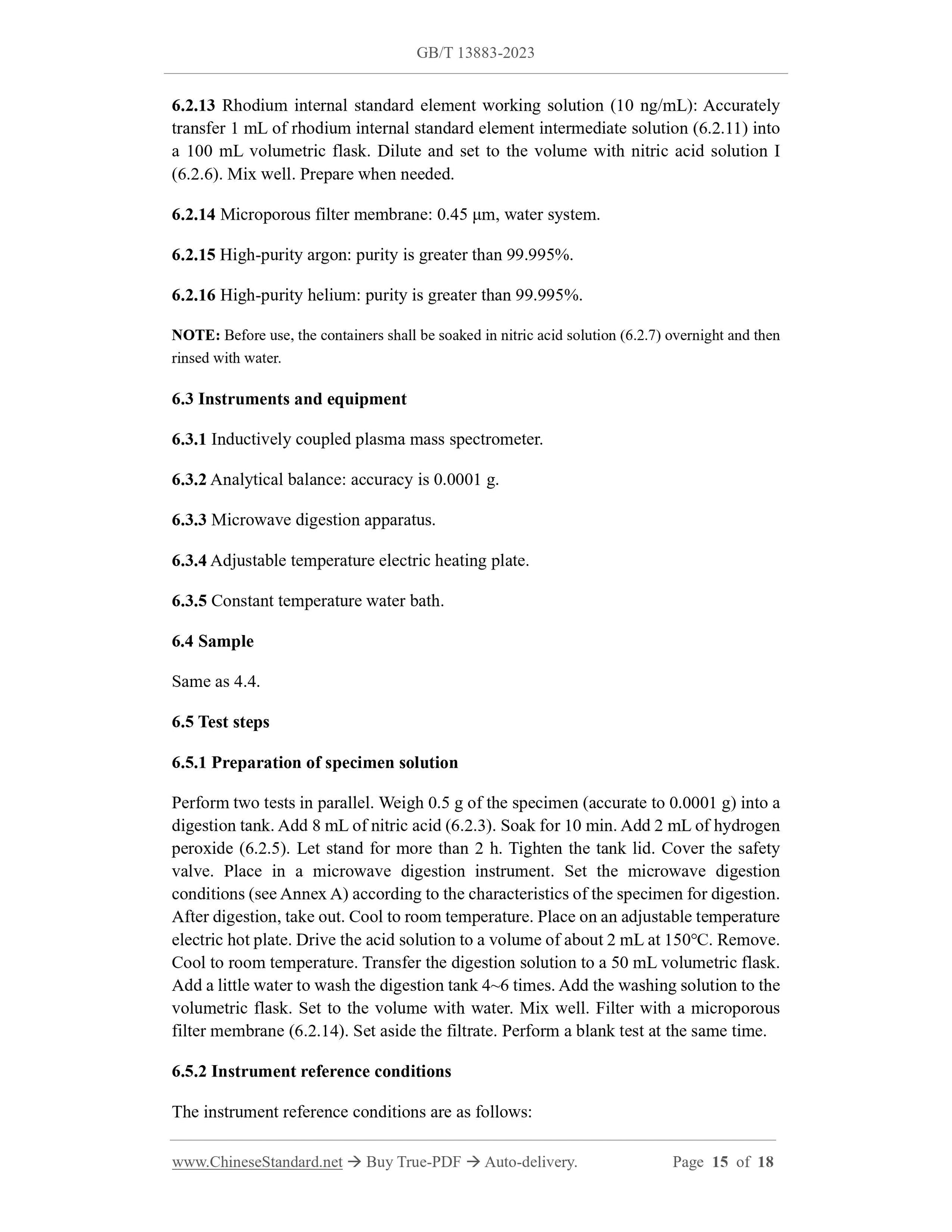1
/
of
10
www.ChineseStandard.us -- Field Test Asia Pte. Ltd.
GB/T 13883-2023 English PDF (GB/T13883-2023)
GB/T 13883-2023 English PDF (GB/T13883-2023)
Regular price
$230.00
Regular price
Sale price
$230.00
Unit price
/
per
Shipping calculated at checkout.
Couldn't load pickup availability
GB/T 13883-2023: Determination of selenium in feeds
Delivery: 9 seconds. Download (& Email) true-PDF + Invoice.
Get Quotation: Click GB/T 13883-2023 (Self-service in 1-minute)
Historical versions (Master-website): GB/T 13883-2023
Preview True-PDF (Reload/Scroll-down if blank)
GB/T 13883-2023
GB
NATIONAL STANDARD OF THE
PEOPLE’S REPUBLIC OF CHINA
ICS 65.120
CCS B 46
Replacing GB/T 13883-2008
Determination of selenium in feeds
ISSUED ON: AUGUST 06, 2023
IMPLEMENTED ON: MARCH 01, 2024
Issued by: State Administration for Market Regulation;
Standardization Administration of the People's Republic of China.
Table of Contents
Foreword ... 3
1 Scope ... 4
2 Normative references ... 4
3 Terms and definitions ... 4
4 Hydride generation-atomic fluorescence spectrometry (arbitration method) ... 4
5 Fluorescence spectrophotometry ... 9
6 Inductively coupled plasma mass spectrometry ... 13
Annex A (informative) Reference conditions for microwave digestion ... 18
Determination of selenium in feeds
1 Scope
This document describes the determination of selenium in feeds by hydride generation-
atomic fluorescence spectrometry, fluorescence spectrophotometry and inductively
coupled plasma-mass spectrometry.
In this document, hydride generation-atomic fluorescence spectrometry and
fluorescence spectrophotometry are applicable to the determination of selenium in
compound feed, concentrated feed, concentrate supplement, additive premix feed and
feed raw materials. Inductively coupled plasma mass spectrometry is applicable to the
determination of selenium in compound feed, concentrated feed, concentrate
supplement and feed raw materials (except mineral feed raw materials).
When the sample size is 1 g and the fixed volume is 50 mL, the detection limit of
hydride generation-atomic fluorescence spectrometry and fluorescence
spectrophotometry is 0.01 mg/kg and the quantification limit is 0.02 mg/kg. When the
sample size is 0.5 g and the fixed volume is 50 mL, the detection limit of inductively
coupled plasma mass spectrometry is 0.01 mg/kg and the quantification limit is 0.02
mg/kg.
2 Normative references
The following referenced documents are indispensable for the application of this
document. For dated references, only the edition cited applies. For undated references,
the latest edition of the referenced document (including any amendments) applies.
GB/T 6682, Water for analytical laboratory use - Specification and test methods
GB/T 20195, Animal feed - Preparation of test samples
3 Terms and definitions
There are no terms or definitions that require definition in this document.
4 Hydride generation-atomic fluorescence spectrometry
(arbitration method)
4.1 Principle
After the specimen is digested with acid, the selenium in the specimen digestion
solution is reduced to tetravalent selenium in the hydrochloric acid medium. Potassium
borohydride is used as a reducing agent to reduce tetravalent selenium to hydrogen
selenide in the hydrochloric acid medium. It is carried into the atomizer by the carrier
gas for atomization. Under the irradiation of the selenium hollow cathode lamp, the
ground state selenium atoms are excited to a high energy state. When deactivated and
returned to the ground state, fluorescence of a characteristic wavelength is emitted. Its
fluorescence intensity is proportional to the selenium content and is quantitatively
compared with the standard series.
4.2 Reagents or materials
Warning -- All strong acids shall be handled with caution. Dilution and use shall
be carried out in a fume hood. When using perchloric acid, be careful not to burn
it dry. Be careful of explosion.
Unless otherwise specified, only analytically pure reagents are used.
4.2.1 Water: GB/T 6682, Grade II.
4.2.2 Nitric acid: guaranteed reagent.
4.2.3 Perchloric acid: guaranteed reagent.
4.2.4 Hydrochloric acid: guaranteed reagent.
4.2.5 Sodium hydroxide: guaranteed reagent.
4.2.6 Hydrogen peroxide.
4.2.7 Potassium borohydride: guaranteed reagent.
4.2.8 Mixed acid solution: Measure 400 mL of nitric acid (4.2.2) and mix with 100 mL
of perchloric acid (4.2.3).
4.2.9 Hydrochloric acid solution I: Measure 100 mL of hydrochloric acid (4.2.4) and
mix with 100 mL of water.
4.2.10 Hydrochloric acid solution II: Pipette 5 mL of hydrochloric acid (4.2.4) and mix
with 95 mL of water.
4.2.11 Sodium hydroxide solution (5 g/L): Weigh 5 g of sodium hydroxide. Dissolve it
in water. Set volume to 1000 mL. Mix well.
4.2.12 Potassium borohydride solution (20 g/L): Weigh 20 g of potassium borohydride.
Dissolve it in 1000 mL of sodium hydroxide solution (4.2.11). Mix well.
4.2.13 Potassium ferrocyanide solution (200 g/L): Weigh 20 g of potassium
ferrocyanide. Dissolve it in 100 mL of water. Mix well.
to an accuracy of 0.0001 g. Place in a 100 mL tall beaker. Add 15 mL of mixed acid
solution (4.2.8) (10 mL of additive premix feed) and a few glass beads. Cover with a
watch glass. Leave for more than 12 h. Place on a thermostatically adjustable hot plate
and gradually heat [if the solution becomes darker during heating, remove it. After
cooling to room temperature, add 5 mL of mixed acid solution (4.2.8). Continue
heating]. When a large amount of white smoke is produced on the upper layer of the
solution and the remaining solution volume is about 2 mL, remove it and cool to room
temperature. Add 5 mL of hydrochloric acid solution I (4.2.9). Place on a
thermostatically adjustable electric stove and heat until smoking. The remaining
volume is about 2 mL. Remove it. Cool to room temperature. Transfer to a 50 mL
volumetric flask with water. Add 8 mL of hydrochloric acid (4.2.4) and 2 mL of
potassium ferrocyanide solution (4.2.13). Set to the volume with water. Mix well and
use this as the specimen solution. Perform a blank test at the same time.
4.5.1.2 Microwave digestion
Perform two tests in parallel. Weigh 0.5 g (accurate to 0.000l g) of the specimen into a
polytetrafluoroethylene inner tank. Add 8 mL of nitric acid (4.2.2). Soak for 10 min.
Then add 2 mL of hydrogen peroxide (4.2.6). Let stand for more than 2 h. Cover the
safety valve. Install the protective cover. Place the digestion tank into the microwave
digestion instrument. Set the microwave digestion conditions (see Annex A) and digest
the sample. After the digestion is completed, open the tank cover to vent after cooling
to room temperature. Rinse the inner cover with a small amount of water. Add the
washing liquid to the tank. Place it on an adjustable temperature electric heating plate.
Continue heating at 150℃ until the residual volume is about 2 mL. Remove. Cool. Add
5 mL of hydrochloric acid solution I (4.2.9). Continue heating until the residual volume
is about 2 mL. Remove. Cool to room temperature. Transfer the digestion solution to a
25 mL volumetric flask. Add a small amount of water to wash the digestion tank 4~6
times. Add the washing solution to a volumetric flask. Add 4 mL of hydrochloric acid
(4.2.4) and 1 mL of potassium ferrocyanide solution (4.2.13). Set to the volume with
water. Mix well and use as the specimen solution. Perform a blank test at the same time.
4.5.2 Preparation of standard series solutions
Accurately pipette 0 mL, 0.2 mL, 0.5 mL, 2 mL, 5 mL, 10 mL, 20 mL of selenium
standard intermediate solution II (4.2.16). Place them in 50 mL volumetric flasks,
respectively. Add water to 30 mL. Add 8 mL of hydrochloric acid (4.2.4) and 2 mL of
potassium ferrocyanide solution (4.2.13). Dilute to the mark with water. Mix well.
Prepare a series of selenium standard solutions with mass concentrations of 0 ng/mL,
0.4 ng/mL, 1 ng/mL, 4 ng/mL, 10 ng/mL, 20 ng/mL, and 40 ng/mL. Prepare when
needed.
4.5.3 Instrument reference conditions
The instrument reference conditions are as follows:
a) Negative high voltage: 200 V~400 V;
b) Selenium hollow cathode lamp current: 15 mA~100 mA;
c) Atomizer temperature: 200℃;
d) Atomizer height: 8 mm;
e) Carrier gas flow rate: 400 mL/min;
f) Shielding gas flow rate: 1000 mL/min.
4.5.4 Determination
Adjust the instrument to the best working state. Start the measurement after stabilizing
for 15 min~20 min. Use hydrochloric acid solution II (4.2.10) as the carrier and
potassium borohydride solution (4.2.12) as the reducing agent. Use the carrier solution
for continuous injection. After the fluorescence intensity is stable, measure the
fluorescence intensity of the standard series solution, blank test solution and specimen
solution in turn. Draw a standard curve with selenium concentration as the horizontal
axis and fluorescence intensity as the vertical axis. The correlation coefficient r of the
standard curve is not less than 0.99. From the standard curve, find the concentration of
selenium in the specimen solution. If the fluorescence intensity of selenium in the
specimen solution exceeds the linear range of the curve, take an appropriate amount of
specimen solution for dilution. Add an appropriate amount of hydrochloric acid (4.2.4)
and potassium ferrocyanide solution (4.2.13). Ensure that the concentrations of
hydrochloric acid and potassium ferrocyanide in the diluted specimen solution are
consistent with those of the standard series solution. Re-measure.
NOTE: Before measuring the reagent blank solution and specimen solution, use hydrochloric acid
solution II (4.2.10) to clean the sample until the fluorescence value is consistent with the reagent
blank.
4.6 Test data processing
The selenium content w1 in the specimen is expressed as mass fraction. The value is
expressed in milligrams per kilogram (mg/kg), calculated according to formula (1):
Where,
ρ1 - the mass concentration of selenium in the specimen solution obtained from the
standard curve, in nanograms per milliliter (ng/mL);
ρ0 - the mass concentration of selenium in the blank test solution obtained from the
5.2.3 Nitric acid: guaranteed reagent.
5.2.4 Hydrochloric acid: guaranteed reagent.
5.2.5 Hydrogen peroxide.
5.2.6 Cyclohexane: guaranteed reagent. If there is interference at the measurement
wavelength, it shall be redistilled.
5.2.7 Ammonia solution: Mix 100 mL of ammonia solution and 100 mL of water.
5.2.8 Hydrochloric acid solution III: Take 250 mL of hydrochloric acid (5.2.4) and mix
with 750 mL of water.
5.2.9 Hydrochloric acid solution IV: Pipette 8.4 mL of hydrochloric acid (5.2.4) into a
1000 mL volumetric flask. Dilute with water, set to the volume, and mix well.
5.2.10 Hydroxylamine hydrochloride-ethylenediaminetetraacetic acid disodium
solution: Weigh 10 g of ethylenediaminetetraacetic acid disodium and dissolve it in 500
mL of water. Add 25 g of hydroxylamine hydrochloride. Stir to dissolve. Dilute to 1000
mL with water. Mix well.
5.2.11 2,3-Diaminonaphthalene solution: Weigh 0.1 g of 2,3-diaminonaphthalene into
a 250 mL beaker. Add 100 mL of hydrochloric acid solution IV (5.2.9) to dissolve it.
Transfer to a 250 mL separatory funnel. Add 20 mL of cyclohexane (5.2.6). Shake for
1 min. After separation, discard the cyclohexane. Repeat the treatment of the aqueous
phase with cyclohexane 2~3 times. Put the aqueous phase into a brown bottle. Cover it
with 1 cm thick cyclohexane (5.2.6). Store it at 2℃~8℃. If necessary, purify it with
cyclohexane before use.
5.2.12 Cresol red indicator (0.4 g/L): Weigh 0.04 g of cresol red into a 150 mL beaker.
Add a small amount of ammonia solution (5.2.7) to dissolve it. Dilute to 100 mL with
water. Mix well.
5.2.13 Selenium standard stock solution (100 μg/mL): Accurately weigh 100 mg of
selenium powder (CAS No.: 7782-49-2, spectrally pure, purity not less than 99.9%) and
dissolve it in a small amount of nitric acid (5.2.3). Add 2 mL of perchloric acid (5.2.2).
Heat in a boiling water bath for 3 h~4 h. After cooling, add 8.4 mL of hydrochloric acid
(5.2.4). Heat in a boiling water bath for another 2 min. Transfer to a 1000 mL volumetric
flask with water. Dilute to the mark with water. Mix well. Store at 2℃~8℃. It shall be
valid for 3 months. Or purchase certified standard substances.
5.2.14 Selenium standard intermediate solution (1 μg/mL): Accurately transfer 1 mL of
selenium standard stock solution (5.2.13) into a 100 mL volumetric flask. Dilute to the
volume with water. Mix well. Prepare when needed.
5.2.15 Selenium standard working solution (0.2 μg/mL): Accurately transfer 10 mL of
selenium standard intermediate solution (5.2.14) into a 50 mL volumetric flask. Dilute
with a small amount of water. Add the washing liquid to the digestion solution. Place
on an adjustable temperature electric hot plate and continue heating at 150℃ until the
remaining volume is about 2 mL. Remove. Cool to room temperature. Add 1 mL of
water and 1 mL of hydrochloric acid solution III (5.2.8). Mix well. Let stand for 10 min.
Transfer the digestion solution to a 50 mL stoppered colorimetric tube. Add a little water
to wash the digestion tank 4~6 times. Add the washing solution to the stoppered
colorimetric tube (For specimens with high selenium content, first transfer the digestion
solution to a 100 mL volumetric flask. Dilute and set to the volume with water. After
mixing, take an appropriate amount of solution into a 50 mL stoppered colorimetric
tube). Add water to about 30 mL. Mix well. Set aside. Perform a blank test at the same
time.
5.5.2 Extraction
Add 2 drops of cresol red indicator (5.2.12) to the sample digestion solution. Adjust
with ammonia solution (5.2.7) until the solution turns yellow. Adjust with hydrochloric
acid solution III (5.2.8) until the solution turns orange (pH 1.5~2), then add 3 mL of
hydroxylamine hydrochloride-ethylenediaminetetraacetic acid disodium solution
(5.2.10). Shake well. Add 2 mL of 2,3-diaminonaphthalene solution (5.2.11). Cover the
stopper. Shake well. Unscrew the stopper. Keep in boiling water for 5 min. Take out.
Cool to room temperature. Dilute to the mark with hydrochloric acid solution IV (5.2.9).
Add 5 mL of cyclohexane (5.2.6). Shake vigorously for 1 min. After standing for
stratification, take the upper layer solution as the specimen solution for testing.
5.5.3 Preparation of standard curve
Accurately pipette 0 mL, 0.1 mL, 0.5 mL, 2 mL, 3 mL, and 4 mL of selenium standard
working solution (5.2.15) into 50 mL stoppered colorimetric tubes, respectively. The
equivalent sele...
Delivery: 9 seconds. Download (& Email) true-PDF + Invoice.
Get Quotation: Click GB/T 13883-2023 (Self-service in 1-minute)
Historical versions (Master-website): GB/T 13883-2023
Preview True-PDF (Reload/Scroll-down if blank)
GB/T 13883-2023
GB
NATIONAL STANDARD OF THE
PEOPLE’S REPUBLIC OF CHINA
ICS 65.120
CCS B 46
Replacing GB/T 13883-2008
Determination of selenium in feeds
ISSUED ON: AUGUST 06, 2023
IMPLEMENTED ON: MARCH 01, 2024
Issued by: State Administration for Market Regulation;
Standardization Administration of the People's Republic of China.
Table of Contents
Foreword ... 3
1 Scope ... 4
2 Normative references ... 4
3 Terms and definitions ... 4
4 Hydride generation-atomic fluorescence spectrometry (arbitration method) ... 4
5 Fluorescence spectrophotometry ... 9
6 Inductively coupled plasma mass spectrometry ... 13
Annex A (informative) Reference conditions for microwave digestion ... 18
Determination of selenium in feeds
1 Scope
This document describes the determination of selenium in feeds by hydride generation-
atomic fluorescence spectrometry, fluorescence spectrophotometry and inductively
coupled plasma-mass spectrometry.
In this document, hydride generation-atomic fluorescence spectrometry and
fluorescence spectrophotometry are applicable to the determination of selenium in
compound feed, concentrated feed, concentrate supplement, additive premix feed and
feed raw materials. Inductively coupled plasma mass spectrometry is applicable to the
determination of selenium in compound feed, concentrated feed, concentrate
supplement and feed raw materials (except mineral feed raw materials).
When the sample size is 1 g and the fixed volume is 50 mL, the detection limit of
hydride generation-atomic fluorescence spectrometry and fluorescence
spectrophotometry is 0.01 mg/kg and the quantification limit is 0.02 mg/kg. When the
sample size is 0.5 g and the fixed volume is 50 mL, the detection limit of inductively
coupled plasma mass spectrometry is 0.01 mg/kg and the quantification limit is 0.02
mg/kg.
2 Normative references
The following referenced documents are indispensable for the application of this
document. For dated references, only the edition cited applies. For undated references,
the latest edition of the referenced document (including any amendments) applies.
GB/T 6682, Water for analytical laboratory use - Specification and test methods
GB/T 20195, Animal feed - Preparation of test samples
3 Terms and definitions
There are no terms or definitions that require definition in this document.
4 Hydride generation-atomic fluorescence spectrometry
(arbitration method)
4.1 Principle
After the specimen is digested with acid, the selenium in the specimen digestion
solution is reduced to tetravalent selenium in the hydrochloric acid medium. Potassium
borohydride is used as a reducing agent to reduce tetravalent selenium to hydrogen
selenide in the hydrochloric acid medium. It is carried into the atomizer by the carrier
gas for atomization. Under the irradiation of the selenium hollow cathode lamp, the
ground state selenium atoms are excited to a high energy state. When deactivated and
returned to the ground state, fluorescence of a characteristic wavelength is emitted. Its
fluorescence intensity is proportional to the selenium content and is quantitatively
compared with the standard series.
4.2 Reagents or materials
Warning -- All strong acids shall be handled with caution. Dilution and use shall
be carried out in a fume hood. When using perchloric acid, be careful not to burn
it dry. Be careful of explosion.
Unless otherwise specified, only analytically pure reagents are used.
4.2.1 Water: GB/T 6682, Grade II.
4.2.2 Nitric acid: guaranteed reagent.
4.2.3 Perchloric acid: guaranteed reagent.
4.2.4 Hydrochloric acid: guaranteed reagent.
4.2.5 Sodium hydroxide: guaranteed reagent.
4.2.6 Hydrogen peroxide.
4.2.7 Potassium borohydride: guaranteed reagent.
4.2.8 Mixed acid solution: Measure 400 mL of nitric acid (4.2.2) and mix with 100 mL
of perchloric acid (4.2.3).
4.2.9 Hydrochloric acid solution I: Measure 100 mL of hydrochloric acid (4.2.4) and
mix with 100 mL of water.
4.2.10 Hydrochloric acid solution II: Pipette 5 mL of hydrochloric acid (4.2.4) and mix
with 95 mL of water.
4.2.11 Sodium hydroxide solution (5 g/L): Weigh 5 g of sodium hydroxide. Dissolve it
in water. Set volume to 1000 mL. Mix well.
4.2.12 Potassium borohydride solution (20 g/L): Weigh 20 g of potassium borohydride.
Dissolve it in 1000 mL of sodium hydroxide solution (4.2.11). Mix well.
4.2.13 Potassium ferrocyanide solution (200 g/L): Weigh 20 g of potassium
ferrocyanide. Dissolve it in 100 mL of water. Mix well.
to an accuracy of 0.0001 g. Place in a 100 mL tall beaker. Add 15 mL of mixed acid
solution (4.2.8) (10 mL of additive premix feed) and a few glass beads. Cover with a
watch glass. Leave for more than 12 h. Place on a thermostatically adjustable hot plate
and gradually heat [if the solution becomes darker during heating, remove it. After
cooling to room temperature, add 5 mL of mixed acid solution (4.2.8). Continue
heating]. When a large amount of white smoke is produced on the upper layer of the
solution and the remaining solution volume is about 2 mL, remove it and cool to room
temperature. Add 5 mL of hydrochloric acid solution I (4.2.9). Place on a
thermostatically adjustable electric stove and heat until smoking. The remaining
volume is about 2 mL. Remove it. Cool to room temperature. Transfer to a 50 mL
volumetric flask with water. Add 8 mL of hydrochloric acid (4.2.4) and 2 mL of
potassium ferrocyanide solution (4.2.13). Set to the volume with water. Mix well and
use this as the specimen solution. Perform a blank test at the same time.
4.5.1.2 Microwave digestion
Perform two tests in parallel. Weigh 0.5 g (accurate to 0.000l g) of the specimen into a
polytetrafluoroethylene inner tank. Add 8 mL of nitric acid (4.2.2). Soak for 10 min.
Then add 2 mL of hydrogen peroxide (4.2.6). Let stand for more than 2 h. Cover the
safety valve. Install the protective cover. Place the digestion tank into the microwave
digestion instrument. Set the microwave digestion conditions (see Annex A) and digest
the sample. After the digestion is completed, open the tank cover to vent after cooling
to room temperature. Rinse the inner cover with a small amount of water. Add the
washing liquid to the tank. Place it on an adjustable temperature electric heating plate.
Continue heating at 150℃ until the residual volume is about 2 mL. Remove. Cool. Add
5 mL of hydrochloric acid solution I (4.2.9). Continue heating until the residual volume
is about 2 mL. Remove. Cool to room temperature. Transfer the digestion solution to a
25 mL volumetric flask. Add a small amount of water to wash the digestion tank 4~6
times. Add the washing solution to a volumetric flask. Add 4 mL of hydrochloric acid
(4.2.4) and 1 mL of potassium ferrocyanide solution (4.2.13). Set to the volume with
water. Mix well and use as the specimen solution. Perform a blank test at the same time.
4.5.2 Preparation of standard series solutions
Accurately pipette 0 mL, 0.2 mL, 0.5 mL, 2 mL, 5 mL, 10 mL, 20 mL of selenium
standard intermediate solution II (4.2.16). Place them in 50 mL volumetric flasks,
respectively. Add water to 30 mL. Add 8 mL of hydrochloric acid (4.2.4) and 2 mL of
potassium ferrocyanide solution (4.2.13). Dilute to the mark with water. Mix well.
Prepare a series of selenium standard solutions with mass concentrations of 0 ng/mL,
0.4 ng/mL, 1 ng/mL, 4 ng/mL, 10 ng/mL, 20 ng/mL, and 40 ng/mL. Prepare when
needed.
4.5.3 Instrument reference conditions
The instrument reference conditions are as follows:
a) Negative high voltage: 200 V~400 V;
b) Selenium hollow cathode lamp current: 15 mA~100 mA;
c) Atomizer temperature: 200℃;
d) Atomizer height: 8 mm;
e) Carrier gas flow rate: 400 mL/min;
f) Shielding gas flow rate: 1000 mL/min.
4.5.4 Determination
Adjust the instrument to the best working state. Start the measurement after stabilizing
for 15 min~20 min. Use hydrochloric acid solution II (4.2.10) as the carrier and
potassium borohydride solution (4.2.12) as the reducing agent. Use the carrier solution
for continuous injection. After the fluorescence intensity is stable, measure the
fluorescence intensity of the standard series solution, blank test solution and specimen
solution in turn. Draw a standard curve with selenium concentration as the horizontal
axis and fluorescence intensity as the vertical axis. The correlation coefficient r of the
standard curve is not less than 0.99. From the standard curve, find the concentration of
selenium in the specimen solution. If the fluorescence intensity of selenium in the
specimen solution exceeds the linear range of the curve, take an appropriate amount of
specimen solution for dilution. Add an appropriate amount of hydrochloric acid (4.2.4)
and potassium ferrocyanide solution (4.2.13). Ensure that the concentrations of
hydrochloric acid and potassium ferrocyanide in the diluted specimen solution are
consistent with those of the standard series solution. Re-measure.
NOTE: Before measuring the reagent blank solution and specimen solution, use hydrochloric acid
solution II (4.2.10) to clean the sample until the fluorescence value is consistent with the reagent
blank.
4.6 Test data processing
The selenium content w1 in the specimen is expressed as mass fraction. The value is
expressed in milligrams per kilogram (mg/kg), calculated according to formula (1):
Where,
ρ1 - the mass concentration of selenium in the specimen solution obtained from the
standard curve, in nanograms per milliliter (ng/mL);
ρ0 - the mass concentration of selenium in the blank test solution obtained from the
5.2.3 Nitric acid: guaranteed reagent.
5.2.4 Hydrochloric acid: guaranteed reagent.
5.2.5 Hydrogen peroxide.
5.2.6 Cyclohexane: guaranteed reagent. If there is interference at the measurement
wavelength, it shall be redistilled.
5.2.7 Ammonia solution: Mix 100 mL of ammonia solution and 100 mL of water.
5.2.8 Hydrochloric acid solution III: Take 250 mL of hydrochloric acid (5.2.4) and mix
with 750 mL of water.
5.2.9 Hydrochloric acid solution IV: Pipette 8.4 mL of hydrochloric acid (5.2.4) into a
1000 mL volumetric flask. Dilute with water, set to the volume, and mix well.
5.2.10 Hydroxylamine hydrochloride-ethylenediaminetetraacetic acid disodium
solution: Weigh 10 g of ethylenediaminetetraacetic acid disodium and dissolve it in 500
mL of water. Add 25 g of hydroxylamine hydrochloride. Stir to dissolve. Dilute to 1000
mL with water. Mix well.
5.2.11 2,3-Diaminonaphthalene solution: Weigh 0.1 g of 2,3-diaminonaphthalene into
a 250 mL beaker. Add 100 mL of hydrochloric acid solution IV (5.2.9) to dissolve it.
Transfer to a 250 mL separatory funnel. Add 20 mL of cyclohexane (5.2.6). Shake for
1 min. After separation, discard the cyclohexane. Repeat the treatment of the aqueous
phase with cyclohexane 2~3 times. Put the aqueous phase into a brown bottle. Cover it
with 1 cm thick cyclohexane (5.2.6). Store it at 2℃~8℃. If necessary, purify it with
cyclohexane before use.
5.2.12 Cresol red indicator (0.4 g/L): Weigh 0.04 g of cresol red into a 150 mL beaker.
Add a small amount of ammonia solution (5.2.7) to dissolve it. Dilute to 100 mL with
water. Mix well.
5.2.13 Selenium standard stock solution (100 μg/mL): Accurately weigh 100 mg of
selenium powder (CAS No.: 7782-49-2, spectrally pure, purity not less than 99.9%) and
dissolve it in a small amount of nitric acid (5.2.3). Add 2 mL of perchloric acid (5.2.2).
Heat in a boiling water bath for 3 h~4 h. After cooling, add 8.4 mL of hydrochloric acid
(5.2.4). Heat in a boiling water bath for another 2 min. Transfer to a 1000 mL volumetric
flask with water. Dilute to the mark with water. Mix well. Store at 2℃~8℃. It shall be
valid for 3 months. Or purchase certified standard substances.
5.2.14 Selenium standard intermediate solution (1 μg/mL): Accurately transfer 1 mL of
selenium standard stock solution (5.2.13) into a 100 mL volumetric flask. Dilute to the
volume with water. Mix well. Prepare when needed.
5.2.15 Selenium standard working solution (0.2 μg/mL): Accurately transfer 10 mL of
selenium standard intermediate solution (5.2.14) into a 50 mL volumetric flask. Dilute
with a small amount of water. Add the washing liquid to the digestion solution. Place
on an adjustable temperature electric hot plate and continue heating at 150℃ until the
remaining volume is about 2 mL. Remove. Cool to room temperature. Add 1 mL of
water and 1 mL of hydrochloric acid solution III (5.2.8). Mix well. Let stand for 10 min.
Transfer the digestion solution to a 50 mL stoppered colorimetric tube. Add a little water
to wash the digestion tank 4~6 times. Add the washing solution to the stoppered
colorimetric tube (For specimens with high selenium content, first transfer the digestion
solution to a 100 mL volumetric flask. Dilute and set to the volume with water. After
mixing, take an appropriate amount of solution into a 50 mL stoppered colorimetric
tube). Add water to about 30 mL. Mix well. Set aside. Perform a blank test at the same
time.
5.5.2 Extraction
Add 2 drops of cresol red indicator (5.2.12) to the sample digestion solution. Adjust
with ammonia solution (5.2.7) until the solution turns yellow. Adjust with hydrochloric
acid solution III (5.2.8) until the solution turns orange (pH 1.5~2), then add 3 mL of
hydroxylamine hydrochloride-ethylenediaminetetraacetic acid disodium solution
(5.2.10). Shake well. Add 2 mL of 2,3-diaminonaphthalene solution (5.2.11). Cover the
stopper. Shake well. Unscrew the stopper. Keep in boiling water for 5 min. Take out.
Cool to room temperature. Dilute to the mark with hydrochloric acid solution IV (5.2.9).
Add 5 mL of cyclohexane (5.2.6). Shake vigorously for 1 min. After standing for
stratification, take the upper layer solution as the specimen solution for testing.
5.5.3 Preparation of standard curve
Accurately pipette 0 mL, 0.1 mL, 0.5 mL, 2 mL, 3 mL, and 4 mL of selenium standard
working solution (5.2.15) into 50 mL stoppered colorimetric tubes, respectively. The
equivalent sele...
Share
